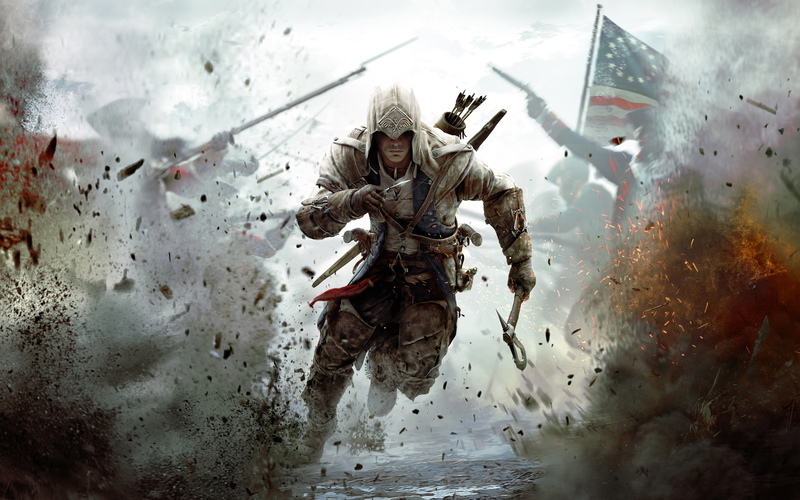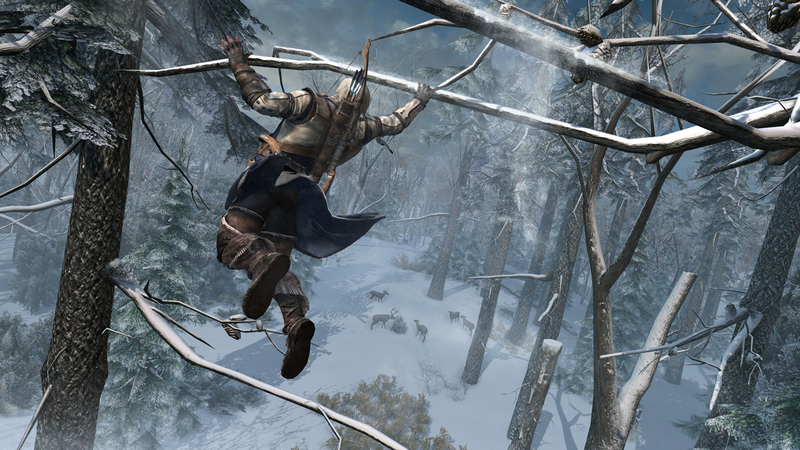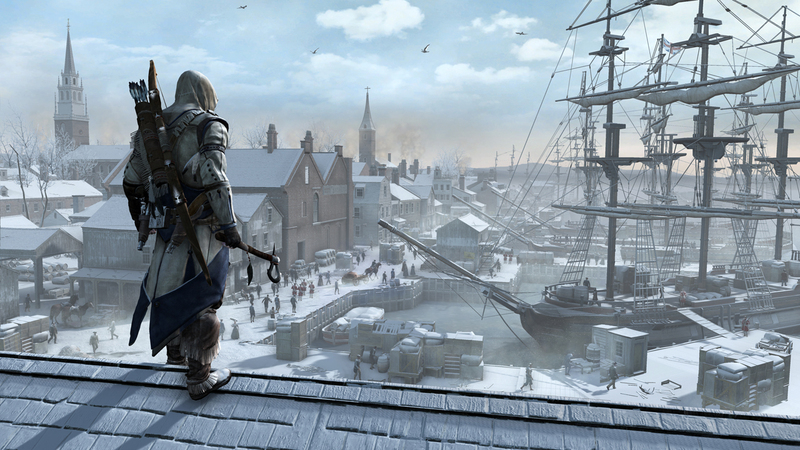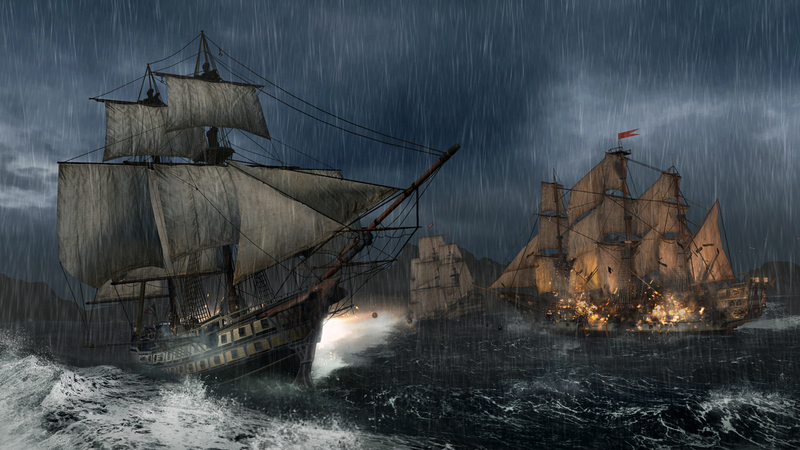How to create Assassin's Creed 3

Translation feature from 245 of the British magazine Edge.
Assassin's Creed III - the largest project in the history of Ubisoft. The development lasted three years; 600 employees were directly involved in the project, not to mention others at Ubisoft studios around the world, including Quebec, Bucharest and Singapore.
')
Only for the new hero of the series, Connor Kenway, 5000+ animations were created with a total duration of more than an hour. In the "extras" involved 120 characters, game mechanics has been enriched with 145 new features. Completes the picture of the new engine AnvilNext. How was such a large-scale game created? For the answer, we went to Montreal. We were welcomed by Francois Pellan, senior producer of ACIII.
“How did you manage to create such a big game? “We ourselves do not fully understand this,” said Pellan. - At the first playable prototype, at the end of the preproduction, when the version for E3 was being assembled, they sat until midnight and nothing worked out. And you come the next day, you see: something has changed, moved from its place over the past few hours. You strain the last forces together with the team, and you get a phenomenal result just in time for the deadline. ”
However, even the most mysterious magic is always a technical explanation. And although the gradual approach to the end of the ACIII does not seem to be particularly romantic, the result is still impressive.
In January 2010, Alex Hutchinson assumed the role of ACIII creative director. Assassins's Creed II just came out and collected positive feedback, but it was already clear that something new was needed. “Obviously, you can't try to sell the same thing over and over again,” Hutchinson recalls, “so the company has set us a paradoxical task: change everything so that everything remains as it was. I had to look for a middle ground between updating the series and a fundamentally new game. ”
Marc-Antoine Lussier, Lead Design Technical Director, notes that it was around the same time that Assassin's Creed: Brotherhood began to be developed, but this project had other objectives. “Brotherhood was much closer to ACII,” he says. - We had a general principle: do not reinvent too much. Use our knowledge and understanding of the mechanic to make the game better - but quickly. With ACIII, the situation was exactly the opposite: to recreate everything that was possible. ”
In previous games, the action took place in warm and dry countries. In ACIII decided to add snow and greenery. Therefore, from the early stages of the project, technical specialists began to sell snow. In addition, I wanted to choose an important historical moment for the project, connected with political intrigues and active actions, but not worn out. The war for US independence came in all respects.
The last major question remained: who will be the new hero? After choosing the era, it became clear that the new assassin should be out of conflict. So a hero of mixed anglo-indian origin appeared. Who else could navigate with confidence in the surrounding wilderness? The drama of national identification allowed the hero to stand out against the background of the rest of the characters in the industry - the usual jocks with huge machine guns.
The wild lands of the American Frontier were given to the colonists with great difficulty, but the task for designers, artists and animators of the Montreal studio Ubisoft was not much easier. Creating a forest required experience, radically different from the developments of the team, and required a whole year of research. The action of the previous games in the series took place in cities, so designers could simply copy entire blocks of objects, placing them differently in different places.
“We immediately realized that there would be difficulties with the forest! - says Lucier. - You can not just set up a row of trees at regular intervals and call it a forest. I had to break my head: "How to create an organic-looking forest, so that it would be convenient to climb trees and jump from one to another?" It is necessary to make both beautifully and functionally. It was a crazy task. ”
First tried a procedural solution. The team tried to set certain parameters (the distance between the trees, the number of branches, etc.) and get an arrangement from the computer. After spending a couple of months, they decided to conduct an experiment and instructed the artists to draw by hand the most beautiful piece of forest with an area of 100 by 100 meters. The work took a week, but at the output the forest began to look much better than a computer simulation. The procedure was abandoned in favor of handwork, leaving more artists to the task. The art director of ACIII, The Chin Ngo, compares the process with the collection of a bouquet of individual flowers, so that it looks beautiful on all sides.

Big cities are no longer a problem for Ubisoft Montreal. But with the forest had to tinker. We needed waterfalls, rocky ledges, landmarks. The beauty of the forest was supposed to smooth out the wretchedness of the colonial architecture.
“One of the problems was that the colonial architecture in comparison with European cities is quite young, with no history. Very simple, even boring. Take Boston Street and Constantinople Street - the difference is enormous, ”Ngo says.
The artists decided to compensate for the primitiveness of the architecture with high detail. For example, wooden window frames are slightly curved due to the scorching sun. The team also tried to reflect the maritime climate of Boston, to show it more humid due to blue tones and puddles. The artists tried to shift the viewer's attention from the buildings to the highly detailed streets, where something is constantly happening. Hutchinson points out that cities in ACIII have record-breaking historical accuracy. They are recreated on a 1: 3 scale based on maps and real topography. Showing us a map of Boston, Hutchinson, as a real guide, talks about the location of the Boston Massacre. In the distance, Beacon Hill rises - it was razed to fill an isthmus in the bay (Boston was originally connected to the mainland by a single bridge).

Screenwriter Matt Turner draws attention to the work of historical consultants - based on the engravings of that era, they suggested what the city should look like. “They came and said, they say, yes, indeed, here is the street of Boston in 1778, but note that there are no animals or beggars on the streets. The street is empty - in fact, everything was completely different. The artist just tried to embellish the city. ” “We couldn’t limit ourselves to just one city,” says Ngo. - That's not enough, it's boring. We were engaged in other areas. Wild forests are only part of the world. We even added sea battles. By the sum of the terms, I am calm for the game. ”
Sea battles were given no easier than forests. This task fell on the shoulders of the Singapore studio. Since the sea scenes are not rich in detail, a significant part of the console's capacity was taken to simulate a realistic ocean.

We ask Yannis Mallat, director of Ubisoft Montreal's studio, if his continued growth in the budgets of AAA-class projects worries him. In response, he cites the example of sea battles: such decisions allow you to maintain sufficient interest in the game so that the development and marketing of the game pays off. “Singapore did everything possible to bring the sea battle to perfection, but this is still a risky element,” he says. “It’s still impossible to say whether this feature will“ shoot ”, but we believe in the talent of our employees.”
New features invented during the eight-week brainstorming called "50 new things." One day a week, all the staff of the studio could work on some new idea of their own, involve other specialists if necessary, and form mini-teams. As a result, a fair amount of ideas came into being. Hutchinson compares the first year of project development with a decreasing box. At first, anything could get into the box, and the management didn’t limit the working time very tightly, provided that the ideas were within the framework of the historical period. As you develop the box decreases, the emphasis shifts to central tasks and work with them.
One of the innovations was fighting on uneven stony surfaces. “Generally they don’t usually do this in games,” Hutchinson sighs. “Look at Batman, other great games: they have their own areas to move, and then large open areas for fights, because otherwise you will have a lot of problems.” Even such imperceptible, seemingly innovation requires careful prototyping.
How on a project of this scale bring together 145 new solutions? ACIII lead programmer Stephen Masters describes the feature approval process as follows. At first he made a brief description for each specific feature. The list was grouped thematically and sent to teams of various directions (AI, battles, tasks, etc.). And already the team was responsible for the development and prototyping of new elements.
For each feature, a set of documents in MS Excel was developed. Designers worked with them, based on them, test-tests were carried out and analyzed. “We threw a bunch of abstract reflections out of the documents,” explains Masters. - I worked on a project where there was a 300-page “bible” in game design. She could slap the table and say "Do this." It was hell, making changes was a nightmare, and getting the staff to read it was just impossible. Our new system is better and more interactive. I take the document, run over my eyes and ask: “But does this thing work as it is written here?”
The ACIII team received the official green light in December 2010 after presenting the overall project structure, prototypes and gameplay video to the company’s management in France. There was no objection. The studio continued to work on a new displacement system, combat mechanics and other ideas. Also began the gradual creation of Boston and forests for gameplay testing. The culmination was the first working prototype of the new mechanics in the new gaming environment, introduced in June 2011.
From that moment, the development went at full speed. A large part of the team of artists joined the project together with programmers and mission designers: work began on creating the game itself. From May to June of the current year, in parallel with the development, work was under way on corrections, so that by October the project would reach the required level of quality.
“These games are doing less and less,” says Hutchinson. - Especially after the "average" games have disappeared from the market. It has always been clear to us that this is a very rare opportunity. We had an experienced team that had already worked on the projects of the series, and the support of the company - we could do something huge. We had almost three years for this, which is rare in our time. Technologies and platforms were already in serious condition, and we did not have to waste time on experiments. Of course, we must not forget about the huge audience on all platforms. Rarely all at once, so we immediately realized that this opportunity may be the only one in his career. ”
Source: https://habr.com/ru/post/158307/
All Articles